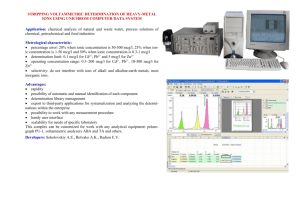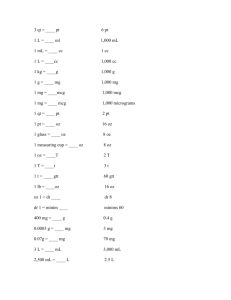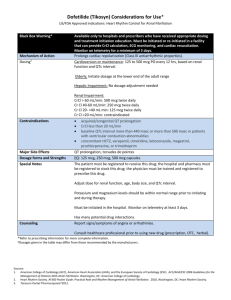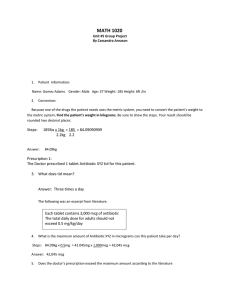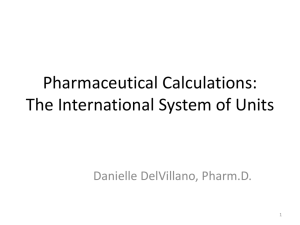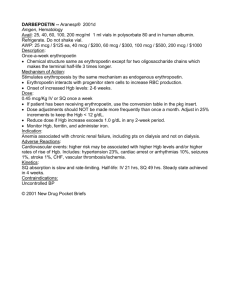In order to find the amount of lead poisoning in... test private and public schools around Mexico City. The researchers...
advertisement
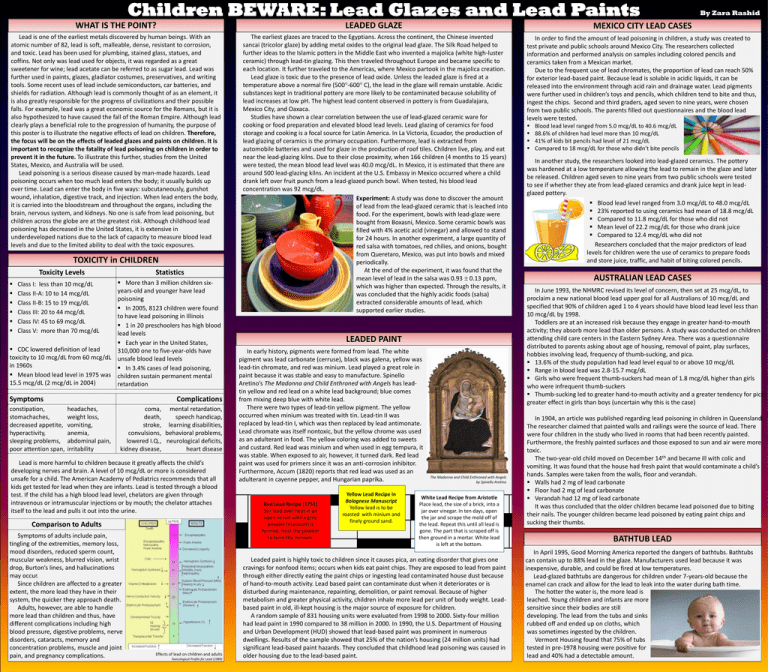
Children BEWARE: Lead Glazes and Lead Paints By Zara Rashid WHAT IS THE POINT? LEADED GLAZE MEXICO CITY LEAD CASES Lead is one of the earliest metals discovered by human beings. With an atomic number of 82, lead is soft, malleable, dense, resistant to corrosion, and toxic. Lead has been used for plumbing, stained glass, statues, and coffins. Not only was lead used for objects, it was regarded as a great sweetener for wine; lead acetate can be referred to as sugar lead. Lead was further used in paints, glazes, gladiator costumes, preservatives, and writing tools. Some recent uses of lead include semiconductors, car batteries, and shields for radiation. Although lead is commonly thought of as an element, it is also greatly responsible for the progress of civilizations and their possible falls. For example, lead was a great economic source for the Romans, but it is also hypothesized to have caused the fall of the Roman Empire. Although lead clearly plays a beneficial role to the progression of humanity, the purpose of this poster is to illustrate the negative effects of lead on children. Therefore, the focus will be on the effects of leaded glazes and paints on children. It is important to recognize the fatality of lead poisoning on children in order to prevent it in the future. To illustrate this further, studies from the United States, Mexico, and Australia will be used. Lead poisoning is a serious disease caused by man-made hazards. Lead poisoning occurs when too much lead enters the body; it usually builds up over time. Lead can enter the body in five ways: subcutaneously, gunshot wound, inhalation, digestive track, and injection. When lead enters the body, it is carried into the bloodstream and throughout the organs, including the brain, nervous system, and kidneys. No one is safe from lead poisoning, but children across the globe are at the greatest risk. Although childhood lead poisoning has decreased in the United States, it is extensive in underdeveloped nations due to the lack of capacity to measure blood lead levels and due to the limited ability to deal with the toxic exposures. The earliest glazes are traced to the Egyptians. Across the continent, the Chinese invented sancai (tricolor glaze) by adding metal oxides to the original lead glaze. The Silk Road helped to further ideas to the Islamic potters in the Middle East who invented a majolica (white high-luster ceramic) through lead-tin glazing. This then traveled throughout Europe and became specific to each location. It further traveled to the Americas, where Mexico partook in the majolica creation. Lead glaze is toxic due to the presence of lead oxide. Unless the leaded glaze is fired at a temperature above a normal fire (500-600 C), the lead in the glaze will remain unstable. Acidic substances kept in traditional pottery are more likely to be contaminated because solubility of lead increases at low pH. The highest lead content observed in pottery is from Guadalajara, Mexico City, and Oaxaca. Studies have shown a clear correlation between the use of lead-glazed ceramic ware for cooking or food preparation and elevated blood lead levels. Lead glazing of ceramics for food storage and cooking is a focal source for Latin America. In La Victoria, Ecuador, the production of lead glazing of ceramics is the primary occupation. Furthermore, lead is extracted from automobile batteries and used for glaze in the production of roof tiles. Children live, play, and eat near the lead-glazing kilns. Due to their close proximity, when 166 children (4 months to 15 years) were tested, the mean blood lead level was 40.0 mcg/dL. In Mexico, it is estimated that there are around 500 lead-glazing kilns. An incident at the U.S. Embassy in Mexico occurred where a child drank left over fruit punch from a lead-glazed punch bowl. When tested, his blood lead concentration was 92 mcg/dL. Experiment: A study was done to discover the amount of lead from the lead-glazed ceramic that is leached into food. For the experiment, bowls with lead-glaze were bought from Boxasni, Mexico. Some ceramic bowls was filled with 4% acetic acid (vinegar) and allowed to stand for 24 hours. In another experiment, a large quantity of red salsa with tomatoes, red chilies, and onions, bought from Queretaro, Mexico, was put into bowls and mixed periodically. At the end of the experiment, it was found that the mean level of lead in the salsa was 0.93 0.13 ppm, which was higher than expected. Through the results, it was concluded that the highly acidic foods (salsa) extracted considerable amounts of lead, which supported earlier studies. In order to find the amount of lead poisoning in children, a study was created to test private and public schools around Mexico City. The researchers collected information and performed analysis on samples including colored pencils and ceramics taken from a Mexican market. Due to the frequent use of lead chromates, the proportion of lead can reach 50% for exterior lead-based paint. Because lead is soluble in acidic liquids, it can be released into the environment through acid rain and drainage water. Lead pigments were further used in children’s toys and pencils, which children tend to bite and thus, ingest the chips. Second and third graders, aged seven to nine years, were chosen from two public schools. The parents filled out questionnaires and the blood lead levels were tested. TOXICITY in CHILDREN Toxicity Levels Statistics More than 3 million children sixyears-old and younger have lead poisoning In 2005, 8123 children were found to have lead poisoning in Illinois 1 in 20 preschoolers has high blood lead levels Each year in the United States, CDC lowered definition of lead 310,000 one to five-year-olds have toxicity to 10 mcg/dL from 60 mcg/dL unsafe blood lead levels in 1960s In 3.4% cases of lead poisoning, Mean blood lead level in 1975 was children sustain permanent mental 15.5 mcg/dL (2 mcg/dL in 2004) retardation Class I: less than 10 mcg/dL Class II-A: 10 to 14 mcg/dL Class II-B: 15 to 19 mcg/dL Class III: 20 to 44 mcg/dL Class IV: 45 to 69 mcg/dL Class V: more than 70 mcg/dL Symptoms constipation, stomachaches, decreased appetite, hyperactivity, sleeping problems, poor attention span, Complications headaches, weight loss, vomiting, anemia, abdominal pain, irritability coma, mental retardation, death, speech handicap, stroke, learning disabilities, convulsions, behavioral problems, lowered I.Q., neurological deficits, kidney disease, heart disease Lead is more harmful to children because it greatly affects the child’s developing nerves and brain. A level of 10 mcg/dL or more is considered unsafe for a child. The American Academy of Pediatrics recommends that all kids get tested for lead when they are infants. Lead is tested through a blood test. If the child has a high blood lead level, chelators are given through intravenous or intramuscular injections or by mouth; the chelator attaches itself to the lead and pulls it out into the urine. Comparison to Adults Symptoms of adults include pain, tingling of the extremities, memory loss, mood disorders, reduced sperm count, muscular weakness, blurred vision, wrist drop, Burton’s lines, and hallucinations may occur. Since children are affected to a greater extent, the more lead they have in their system, the quicker they approach death. Adults, however, are able to handle more lead than children and thus, have different complications including high blood pressure, digestive problems, nerve disorders, cataracts, memory and concentration problems, muscle and joint pain, and pregnancy complications. Effects of lead on children and adults Toxicological Profile for Lead (1989) LEADED PAINT In early history, pigments were formed from lead. The white pigment was lead carbonate (cerruse), black was galena, yellow was lead-tin chromate, and red was minium. Lead played a great role in paint because it was stable and easy to manufacture. Spinello Aretino’s The Madonna and Child Enthroned with Angels has leadtin yellow and red lead on a white lead background; blue comes from mixing deep blue with white lead. There were two types of lead-tin yellow pigment. The yellow occurred when minium was treated with tin. Lead-tin II was replaced by lead-tin I, which was then replaced by lead antimonate. Lead chromate was itself nontoxic, but the yellow chrome was used as an adulterant in food. The yellow coloring was added to sweets and custard. Red lead was minium and when used in egg tempura, it was stable. When exposed to air, however, it turned dark. Red lead paint was used for primers since it was an anti-corrosion inhibitor. Furthermore, Accum (1820) reports that red lead was used as an adulterant in cayenne pepper, and Hungarian paprika. Red Lead Recipe (1751) Stir lead over heat in an open vessel until a grey powder (masticot) is formed. Heat the powder to form the minium. Yellow Lead Recipe in Bolognese Manuscript Yellow lead is to be roasted with minium and finely ground sand. The Madonna and Child Enthroned with Angels by Spinello Aretino White Lead Recipe from Aristotle Place lead, the size of a brick, into a jar over vinegar. In ten days, open the jar and scrape the mold off of the lead. Repeat this until all lead is gone. The part that is scraped off is then ground in a mortar. White lead is left at the bottom. Leaded paint is highly toxic to children since it causes pica, an eating disorder that gives one cravings for nonfood items; occurs when kids eat paint chips. They are exposed to lead from paint through either directly eating the paint chips or ingesting lead contaminated house dust because of hand-to-mouth activity. Lead based paint can contaminate dust when it deteriorates or is disturbed during maintenance, repainting, demolition, or paint removal. Because of higher metabolism and greater physical activity, children inhale more lead per unit of body weight. Leadbased paint in old, ill-kept housing is the major source of exposure for children. A random sample of 831 housing units were evaluated from 1998 to 2000. Sixty-four million had lead paint in 1990 compared to 38 million in 2000. In 1990, the U.S. Department of Housing and Urban Development (HUD) showed that lead-based paint was prominent in numerous dwellings. Results of the sample showed that 25% of the nation’s housing (24 million units) had significant lead-based paint hazards. They concluded that childhood lead poisoning was caused in older housing due to the lead-based paint. Blood lead level ranged from 5.0 mcg/dL to 40.6 mcg/dL 88.6% of children had level more than 10 mcg/dL 41% of kids bit pencils had level of 21 mcg/dL Compared to 18 mcg/dL for those who didn’t bite pencils In another study, the researchers looked into lead-glazed ceramics. The pottery was hardened at a low temperature allowing the lead to remain in the glaze and later be released. Children aged seven to nine years from two public schools were tested to see if whether they ate from lead-glazed ceramics and drank juice kept in leadglazed pottery. Blood lead level ranged from 3.0 mcg/dL to 48.0 mcg/dL 23% reported to using ceramics had mean of 18.8 mcg/dL Compared to 11.8 mcg/dL for those who did not Mean level of 22.2 mcg/dL for those who drank juice Compared to 12.4 mcg/dL who did not Researchers concluded that the major predictors of lead levels for children were the use of ceramics to prepare foods and store juice, traffic, and habit of biting colored pencils. AUSTRALIAN LEAD CASES In June 1993, the NHMRC revised its level of concern, then set at 25 mcg/dL, to proclaim a new national blood lead upper goal for all Australians of 10 mcg/dL and specified that 90% of children aged 1 to 4 years should have blood lead level less than 10 mcg/dL by 1998. Toddlers are at an increased risk because they engage in greater hand-to-mouth activity; they absorb more lead than older persons. A study was conducted on children attending child care centers in the Eastern Sydney Area. There was a questionnaire distributed to parents asking about age of housing, removal of paint, play surfaces, hobbies involving lead, frequency of thumb-sucking, and pica. 13.6% of the study population had lead level equal to or above 10 mcg/dL Range in blood lead was 2.8-15.7 mcg/dL Girls who were frequent thumb-suckers had mean of 1.8 mcg/dL higher than girls who were infrequent thumb-suckers Thumb-sucking led to greater hand-to-mouth activity and a greater tendency for pica; greater effect in girls than boys (uncertain why this is the case) In 1904, an article was published regarding lead poisoning in children in Queensland. The researcher claimed that painted walls and railings were the source of lead. There were four children in the study who lived in rooms that had been recently painted. Furthermore, the freshly painted surfaces and those exposed to sun and air were more toxic. The two-year-old child moved on December 14th and became ill with colic and vomiting. It was found that the house had fresh paint that would contaminate a child’s hands. Samples were taken from the walls, floor and verandah. Walls had 2 mg of lead carbonate Floor had 2 mg of lead carbonate Verandah had 12 mg of lead carbonate It was thus concluded that the older children became lead poisoned due to biting their nails. The younger children became lead poisoned by eating paint chips and sucking their thumbs. BATHTUB LEAD In April 1995, Good Morning America reported the dangers of bathtubs. Bathtubs can contain up to 88% lead in the glaze. Manufacturers used lead because it was inexpensive, durable, and could be fired at low temperatures. Lead-glazed bathtubs are dangerous for children under 7-years-old because the enamel can crack and allow for the lead to leak into the water during bath time. The hotter the water is, the more lead is leached. Young children and infants are more sensitive since their bodies are still developing. The lead from the tubs and sinks rubbed off and ended up on cloths, which was sometimes ingested by the children. Vermont Housing found that 75% of tubs tested in pre-1978 housing were positive for lead and 40% had a detectable amount.
